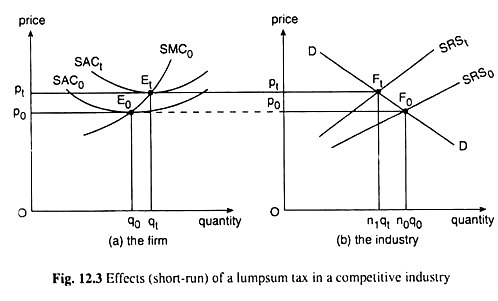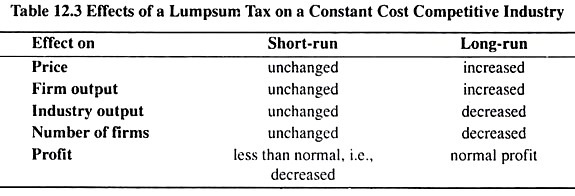We shall try to know here the effects of the tax on a constant cost competitive industry in the short run and in the long run.
The Short-Run Effects of the Tax:
Let us suppose that the picture of a typical firm is given in part (a) of Fig. 12.3 and that of the industry is given in part (b) of the figure. In part (b), the demand curve for the good has been given to be DD. On the other hand, the supply curve of the industry before the imposition of the tax has been given to be SRS0 which is the horizontal summation of the SMC curves of the individual firms in the industry.
The number of such firms is, say, n0. Initially, i.e., before the imposition of the tax, the demand-supply equilibrium price, p0, of the good has been determined at the point of intersection F0 of the demand (DD) and supply (SRS0) curves.
We have assumed that at p = p0, the firm is in short-run and long-run equilibrium at the minimum point of its average cost curves (the long-run AC curve has not been shown), producing q = q0. Therefore, at p = p0, the industry output has been n0qo at the point F0.
To obtain the effects of a lump-sum tax, let us now suppose that the government imposes such a tax of a lump-sum amount of T (Rs) per period, on the good. The firm that produces the good will take it as an increase in its total fixed cost (TFC) per period, and as TFC increases by T, the firm’s total cost (TC) would also increase by T at each output.
The firm’s short-run average cost (SAC) also increases by T/q at any output q, and so its SAC curve will shift upwards from SAC0 to SACt.
The vertical gap between the SACt and SAC0 curves at any output q is equal to T/q, and, for obvious reasons, it falls as q increases. Since the imposition of the lump-sum tax keeps the firm’s total variable cost (TVC) function unaffected, it keeps the firm’s MC function also unaffected, i.e., the firm’s MC function would remain the same as it was before the imposition of the tax—it would remain the same SMC0, and so, the SRS0 curve of the industry which is the horizontal summation of the SMC curves will also remain the same after the imposition of the tax, given the number of firms.
As we know, the SMC curve crosses the SAC function at the latter’s minimum point. Therefore, the SMC0 curve would cross the SAC0 and SAC, curves at their minimum points, E0 and Et. Since the SMC curve at E0 is positively sloped, the point Et would lie upward towards right of point E0, i.e., the firm’s output qt at Et, would be larger than the output q0 at the point E0.
ADVERTISEMENTS:
Since the SRS curve of the industry, viz., SRS0, does not change its position as a result of the imposition of the tax, the price of the good would remain the same at p = p0, and since the SMC curve of the firm would not change its position, the output of the firm, q0 would remain the same, and the number of firms remaining the same at n0, the industry output would also remain unchanged at n0q0.
But now the SAC curve of the firm has shifted upwards from SAC0 to SACt. Therefore, at the p = MC point E0 (p0, q0), the firm would have p < SAC, i.e., the firm would earn economic losses in the short run as a result of the imposition of the lump-sum tax.
The Long-Run Effects of the Tax:
In the long-run adjustment process, some of the firms would be leaving the industry to avoid economic losses. Therefore, the SRS curve of the industry being a horizontal summation now of a smaller number of SMC curves, would be shifting to the left of SRS0.
The DD curve remaining in the same position, the price of the good now would be rising from p0. The process would continue till the number of firms diminishes to, say, n1 (n1 < n0), and the SRS curve shifts to the position of SRSt that intersects the DD curve at Ft to give us p = pt which is a price that puts the firm again in the normal profit-earning equilibrium, for, at p = pt, and at the point Et, the firm’s AR = MR curve touches the SACt curve and intersects the SMC curve.
ADVERTISEMENTS:
At p = pt, the firm’s output would be q = qt which would be larger than q0, and the industry output (at the point Ft) would be n1q1, which is less than the initial level of n0q0. This is because the number of firms in the industry has decreased although the output of each firm has increased.
We may summarise the short-run and long-run effects of the tax in the following table:

